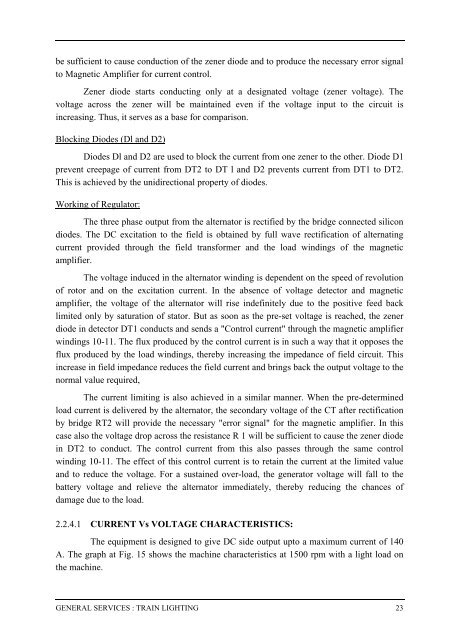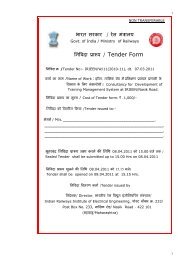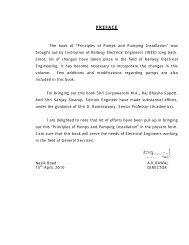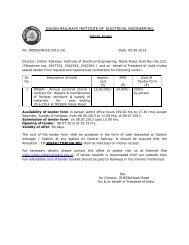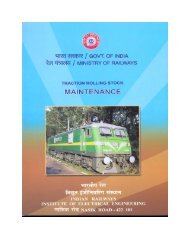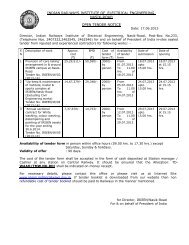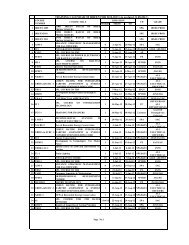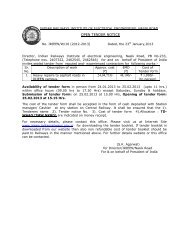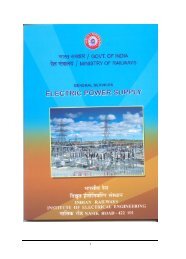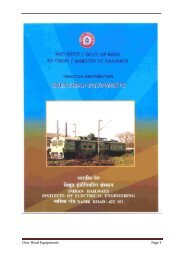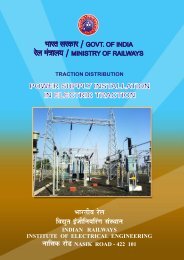Cover - Train Lighting - Indian Railways Institute of Electrical ...
Cover - Train Lighting - Indian Railways Institute of Electrical ...
Cover - Train Lighting - Indian Railways Institute of Electrical ...
Create successful ePaper yourself
Turn your PDF publications into a flip-book with our unique Google optimized e-Paper software.
e sufficient to cause conduction <strong>of</strong> the zener diode and to produce the necessary error signal<br />
to Magnetic Amplifier for current control.<br />
Zener diode starts conducting only at a designated voltage (zener voltage). The<br />
voltage across the zener will be maintained even if the voltage input to the circuit is<br />
increasing. Thus, it serves as a base for comparison.<br />
Blocking Diodes (Dl and D2)<br />
Diodes Dl and D2 are used to block the current from one zener to the other. Diode D1<br />
prevent creepage <strong>of</strong> current from DT2 to DT l and D2 prevents current from DT1 to DT2.<br />
This is achieved by the unidirectional property <strong>of</strong> diodes.<br />
Working <strong>of</strong> Regulator:<br />
The three phase output from the alternator is rectified by the bridge connected silicon<br />
diodes. The DC excitation to the field is obtained by full wave rectification <strong>of</strong> alternating<br />
current provided through the field transformer and the load windings <strong>of</strong> the magnetic<br />
amplifier.<br />
The voltage induced in the alternator winding is dependent on the speed <strong>of</strong> revolution<br />
<strong>of</strong> rotor and on the excitation current. In the absence <strong>of</strong> voltage detector and magnetic<br />
amplifier, the voltage <strong>of</strong> the alternator will rise indefinitely due to the positive feed back<br />
limited only by saturation <strong>of</strong> stator. But as soon as the pre-set voltage is reached, the zener<br />
diode in detector DT1 conducts and sends a "Control current" through the magnetic amplifier<br />
windings 10-11. The flux produced by the control current is in such a way that it opposes the<br />
flux produced by the load windings, thereby increasing the impedance <strong>of</strong> field circuit. This<br />
increase in field impedance reduces the field current and brings back the output voltage to the<br />
normal value required,<br />
The current limiting is also achieved in a similar manner. When the pre-determined<br />
load current is delivered by the alternator, the secondary voltage <strong>of</strong> the CT after rectification<br />
by bridge RT2 will provide the necessary "error signal" for the magnetic amplifier. In this<br />
case also the voltage drop across the resistance R 1 will be sufficient to cause the zener diode<br />
in DT2 to conduct. The control current from this also passes through the same control<br />
winding 10-11. The effect <strong>of</strong> this control current is to retain the current at the limited value<br />
and to reduce the voltage. For a sustained over-load, the generator voltage will fall to the<br />
battery voltage and relieve the alternator immediately, thereby reducing the chances <strong>of</strong><br />
damage due to the load.<br />
2.2.4.1 CURRENT Vs VOLTAGE CHARACTERISTICS:<br />
The equipment is designed to give DC side output upto a maximum current <strong>of</strong> 140<br />
A. The graph at Fig. 15 shows the machine characteristics at 1500 rpm with a light load on<br />
the machine.<br />
GENERAL SERVICES : TRAIN LIGHTING 23


